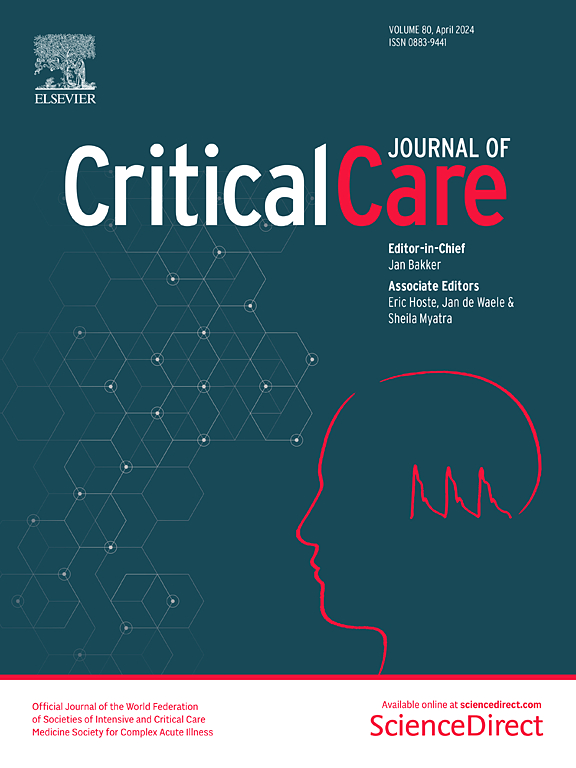An index of the initial blood pressure response to angiotensin II treatment and its association with clinical outcomes in vasodilatory shock
IF 8.8
1区 医学
Q1 CRITICAL CARE MEDICINE
引用次数: 0
Abstract
No standardized index exists to assess cardiovascular responsiveness to angiotensin-II. We hypothesized that a standardized index of initial blood pressure response to angiotensin-II treatment would be associated with clinical outcomes. Using data from the Angiotensin Therapy for High Output Shock (ATHOS-3) trial, we developed an Angiotensin-II Initial MAP Response Index of Treatment Effect (AIMRITE) defined as (MAP at hr1 – MAP at baseline)/study drug dose. We assessed AIMRITE continuously and, based on observed distributions, we additionally categorized patients as “responsive” or “resistant”, with responsiveness defined by an AIMRITE ≥ 0.90 mmHg/ng/kg/min. The primary clinical outcome was 28-day mortality. Secondary outcomes included days alive and vasopressor- or ventilator- or renal replacement therapy-free at day-7. Biological outcomes included baseline renin, angiotensin-II, and renin/angiotensin-II ratio, and their change at hr3. Of 158 placebo patients, as expected, 157 (99%) had AIMRITE < 0.90 mmHg/ng/kg/min (median AIMRITE 0.02; IQR − 0.03–0.10). In contrast, 163 patients assigned to angiotensin-II had a median AIMRITE of 1.43 mmHg/ng/kg/min (IQR 0.35–2.83). Of these, 97 (60%) were responsive (median AIMRITE 2.55; IQR 1.66–4.12) and 66 (40%) were resistant (median AIMRITE 0.24; IQR 0.10–0.52). Each 1.0-unit increase in AIMRITE was associated with a 16% lower hazard of death (HR: 0.84 per-mmHg/ng/kg/min [95% CI 0.74–0.95], p = 0.0062). Responsive patients had half the mortality hazard than resistant patients (HR: 0.50 [95% CI 0.32–0.78], p = 0.0026) and placebo patients (HR 0.58 [95% CI 0.40–0.86], p = 0.0064). Resistant patients had a similar mortality hazard to placebo (HR 1.17 [95% CI 0.80–1.72], p = 0.41). Compared to resistant patients, responsive patients had lower baseline renin and renin/angiotensin-II ratio, but a greater decrease in both at hr3. When stratified by baseline renin level, mortality was highest in placebo patients with high renin (69%) and angiotensin-II resistant patients with low renin (61%). Among patients with catecholamine-refractory vasodilatory shock treated with angiotensin-II, the AIMRITE was associated with mortality at day-28. Responsive angiotensin-II patients had higher survival versus both angiotensin-II resistant patients and those treated with placebo plus standard vasopressors. This index may serve as a prognostic indicator and early identifier of patients most likely to benefit from angiotensin-II.求助全文
约1分钟内获得全文
求助全文
来源期刊

Critical Care
医学-危重病医学
CiteScore
20.60
自引率
3.30%
发文量
348
审稿时长
1.5 months
期刊介绍:
Critical Care is an esteemed international medical journal that undergoes a rigorous peer-review process to maintain its high quality standards. Its primary objective is to enhance the healthcare services offered to critically ill patients. To achieve this, the journal focuses on gathering, exchanging, disseminating, and endorsing evidence-based information that is highly relevant to intensivists. By doing so, Critical Care seeks to provide a thorough and inclusive examination of the intensive care field.
 求助内容:
求助内容: 应助结果提醒方式:
应助结果提醒方式:


